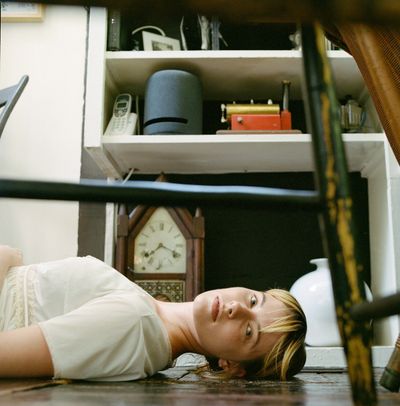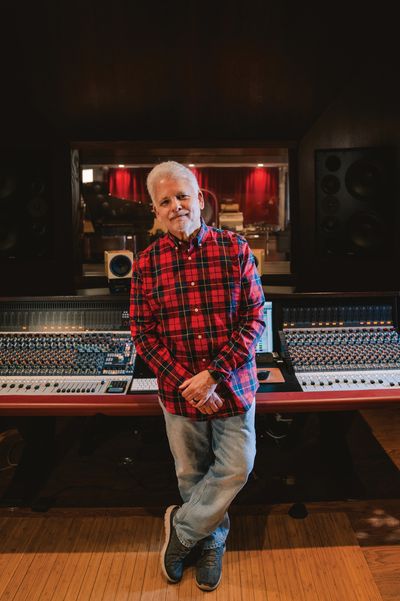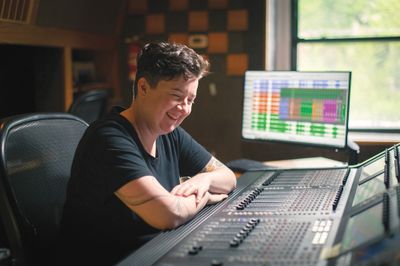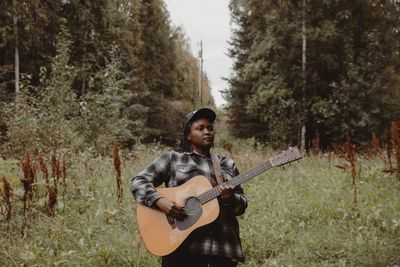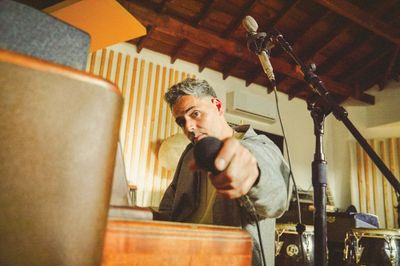At the end of the afternoon, Martin said, "Oh, by the way, I'm just thinking. The problem with having too much material to work with... I think the mind can't really remember like five takes or seven takes. I actually find that three is absolutely the limit. Four fucks it up. And that extra one, even if you can actually digest it, that's going to add an hour to the process." Pointing at my mini-disc recorder, he continues, "So I was just starting to think that with you... You might have a little too much here, and be like, "What the fuck?"
Talking to Martin Bisi is like having a conversation with a large bird with a mild hyperactivity disorder. He swoops in and out of topics, sometimes in seeming non sequitur, but you soon notice that he's referring back to an earlier point in this conversation, or in an earlier one, or just testing ideas. In combination with his intense animation and an arsenal of fascinating technical knowledge, anecdote and philosophy, this keeps your attention, which is how I did in fact end up with several staggering hours of audio to sift through.
From his own youth to Sonic Youth, Bisi has always been a sought-after outsider. A friend of mine, who had gone to high school with him and suggested we meet, told me that in high school, he was orphaned, but he stayed home unsupervised, making his Manhattan apartment the after school hangout for artists, musicians and other wayward types. Through Village Voice ads he connected with Bill Laswell [Tape Op #93], under whose patronage, and with Brian Eno's [#85] seed money, he set up BC Studio in an unused warehouse in the Gowanus section of Brooklyn — an industrial no-man's-land between Park Slope and Red Hook.
Martin Bisi lives and works there to this day, in the three-story space with a huge live room in what was an old truck loading bay. A neon sign maker shares the parking courtyard — a walled compound off 3rd Street lit with the surreal glow of neon, advertising to no one in particular. Over the years BC has been the site for Eno, Iggy Pop, Sonic Youth, Herbie Hancock, Bill Laswell, The Swans, and continues to be a sought after studio, for the space and the added perspective and genius that Bisi brings to his subjects.
Bisi's relationship with Eno soured, but not before recording On Land with the temperamental visionary. He recalls, "I had just put the studio together. I mean literally, the first time I turned on the machines and recorded anything, Brian Eno was standing right next to me. So I was gratified and amazed that it was sounding the way it did, that there was no noise, no buzz, no hums, just from a technical point of view, I was just thrilled." All of his experience to date had been doing live sound at CBGB's, so though Bisi can't attribute Eno's change of mood to a particular technical inadequacy, he mused that it was probably his general inexperience, more than lack of technical flair.
In fact, Bisi remembers Eno's approach to the studio as being "extremely lo-fi and casual, from a technical point of view. For instance, he would clean the heads with his fingers. No alcohol, no head cleaner, no Q-tips. He'd be like, 'Put that shit away,' and it was just his finger. Boom, boom boom, [mimes wiping heads] and we'd go." By comparison, Bisi's downright fastidious: "I don't even touch the leader without washing my hands first. I do think some of those oils could erode the tape gap. That's why you want denatured alcohol instead of isopropyl, you don't want any water, because it'll dissolve the filler in the tape gap, and expose the head, the coil or something. Maybe he didn't know that or didn't care, but it also didn't seem to do anything to my heads, those heads lasted for a few years after that."
On Land is essentially a collection of interesting soundscapes and naturalistic effects, like manipulating a tape loop of frogs one of Bill Laswell's friends had brought from South America, or pebbles from the beach shuffled around in a cigar box. Plus vacuum cleaner tubes. "Swishing them around your head, like kids do, we were doing that. I think we spent a few hours just doing tube takes." These experiments were to be assembled in collage later on. "We recorded a ton of stuff in the course of a month," says Bisi. "A lot of that stuff ended up on other records — that's what people said anyway."
Eno's seemingly lackadaisical approach suited this unusual structural process, motivated it even. As Bisi sees it, Eno "wanted a thing that was weirdly scratchy and poppy... a little fucked up. I think he had some overall picture that didn't necessarily include us. It was very random." They would use the Oblique Strategy cards, a set of cards with one-line instructions, developed by Eno and Peter Schmidt in the 1970s as a kind of jump-starter for stalled creativity. The instructions are sometimes opaquely irrelevant, sometimes eerily synchronous with what's going on, saying things like "Center channel, Right channel, Left channel." Or "Remember those quiet evenings." These are time-diffusing, mind-expanding techniques, typically against the ethos of a clocked and billed recording session. Bisi remembers Eno to pull a card and say, "Oh. Cards say erase the last take. Martin, erase the last take. Or the card read 'Stop now and ask someone else to take charge', so Eno would say, "Martin, you decide what we do next."
"Later on people were doing things like that and running them through amps, or through distortion boxes or whatever, he wasn't doing that, but his thing was to record those sounds in an imperfect environment like this."
Perhaps it was just too imperfect, or maybe bad timing, or a confluence of obstacles, but unexpectedly, given the laid-back atmosphere Eno had set up, he blew a gasket. Bisi, perhaps wishing to forget, has no answers, but he pointed to the wall over my head, indicating where the chair Eno threw had splintered. "He completely lost it. I think there was probably a lot of tension. It might have been other stuff. Part of the tension might have been feeding headphone mixes and stuff. Not purely engineering, but stuff like that."
BC now sports a 24 channel MCI console (bought from Sigma sound, where it was in Room A. Young Americans supposedly found it's way through the circuits.) During On Land, though, Bisi does remember that he was using a Soundcraft live mixing board, which was the board he was familiar with from gigs at CBGB's, plus he liked the EQ on it: "It was very parametric and had a lot of control, and I liked it. That board was very un-flexible, in terms of creating a monitor mix or a monitoring section; it was really a live sound board. Maybe that's why Eno got pissed off. Maybe that was it, because it was kind of hard to feed that, and overdub this, and then monitor... It was very clunky. You know what I'm saying, it wasn't like using the wrong mics that pissed him off." He went on to philosophize that "a lot of being a good engineer, or producer is just logistical. Being able to get a band going soon."
Fast forward ten or fifteen years, and compare Bisi's work on another assemblage recording, the Body Lovers, a side project of the Swans' Michael Gira, which involved tons of overdubs and spliced segments. Bisi's idea, foreseeing a real rabbit-hole of decisions during the arranging and post production, was to crank out ten hasty mixes of each song, playing it really loose, and then taking those as "locked" material, segueing, cross-fading and editing between the mixes, rather than sift through all the stuff in bulk, all the way through. Bisi felt that "the whole thing was cost effective in terms of getting rid of options. A better discipline for [Gira is] to work with finite things. These are the elements, let's work with that."
It's nothing like On Land, musically. But as Bisi categorizes it, "One thing that those two projects have in common is to not even attempt any kind of arrangement until you're way down the line in the post-production stage." This is full immersion into the use of the studio as a compositional tool, instead of documenting performance. On Land and Body Lovers are extreme versions of this, but Bisi likes to see universal principles in things: "I think what that does, which is good to remember for any kind of project, is to remind yourself that you have some room to create some magic at the next step. I try to remind people of that even on projects that are just like basic rock, there's stuff that comes after the basics."
"Cut out the fat. Focus. Make a statement that is as simple as it can be and still work, and as straightforward as it can be." These are the basic rules Bisi sees for drawing out what he calls the "universality" in music he's recording. "My attitude is that there are sort of indifferent listeners. I'm definitely imagining that the listener is not giving a shit, is vacuuming, is doing the dishes, has got the water running, is talking — so I have to work extra hard."
It's also a strategy for pulling artists' heads far enough out of their, uh, projects, to give them needed perspective on their work.
"Perfect is the enemy of good," he says, illustrating with the observation that perfectionism tends to be inversely related to professionalism: "You have someone like Bootsy [Collins], for instance, he wouldn't even listen back to takes of himself. Once we got the sound, he would blow through the take, occasionally stop, back up a little and punch in and keep going, as soon as we got to the end of the song, invariably he would take the bass off and that was it, he wouldn't even listen back. I found that really impressive... And the thing is the takes were good. There wasn't much need to obsess about if it was on the beat here, or a little rushing here or a little behind the beat there. Sly and Robbie, same thing. Someone like Iggy Pop, he wouldn't even be here when we were comping the vocals... just like Kim and Thurston, come back just to double check that we hadn't fucked it up and that was it."
Bisi waves off the suggestion that Herbie Hancock's "Rockit" was largely his project, a subject of rumor among some of his recent clients, but he did have a major hand in creating the DMX grooves and "samples" that turned into Herbie's jazz-hip/hop crossover hit. Anyone who has tooled around with the loop/hold function on many delay units has probably at one point experimented with an extremely primitive sort of proto-sampling. You can't keymap, or trigger very accurately, but you can capture a short loop of a recording, and through judicious fading and muting, you can replicate the basic function of a sampler. Most people discover this at an early stage of home recording experimentation.
In 1983, Bisi had no actual samplers, so he used this technique on "Rockit", for the guitar "sample" at the beginning of every cycle of the main groove. Running Led Zeppelin's Coda through a PCM 42, he caught a chunk of guitar that he liked, and each time the verse came around, [he'd] just bring the fader up, and it was bussed to tape, a technique he describes as very much "trial and error. Obviously most of the time it's going to be off, stutter or be out of time or what ever. But miraculously, like one out of six times, it would be dead on."
This experimentation was born, in part, from the certainty that this was to be a demo for Herbie, which would be totally redone as he overdubbed his keyboard and vocals in L.A. But of course, Herbie liked the raw simplicity of the track as is, and what you hear is the BC demo, with Herbie on top.
Being an outsider gives a certain perspective, something that perhaps enabled Bisi to bring some of his prized universality to the sessions he recorded with Sonic Youth. He claims he didn't fit in with them, and in fact "contradicted their philosophy. At the time," he says, "they were like 'anti-big' This was the time of no-wave, nobody wants to be big. God forbid. I mean, Yes wants to be big, and spacious. But I heard something in there, it sort of begs that some of that stuff WAS pretty, with the chimey overtones. That's not the first thing you'd read in their bio, 'Oh, we're a band making beautiful music.' I hear it and I think it's kind of pretty, or here's something that they wouldn't want to admit right away. I do think it's kind of dramatic. Kind of powerful." And so, without outright disobedience, Bisi would try to gently push things in a direction, adding a little bit of ambience, reverb, just enough so "Maybe it's not all just shitty."
"And of course," he recalls "there was a thing where Thurston would be happy, but he'd be reluctantly happy. He'd go, 'Martin, sounds good, sounds too good, I dunno,'" Bisi half-sings, in warning tones. In the end, Thurston let Bisi do his thing, however contradictory to the Sonic Youth aesthetic, but those who sought really raw sound wouldn't come to Bisi. "Pussy Galore definitely did not call me," he says.
Recently, Bisi's been most excited about working more with Gira, and with New York bands like the Ex- Models, Bee and Flower, Barbez and Boston's Dresden Dolls. Recording with the latter, he had an interesting thought on piano bands:
"You almost need different pianos for different types of songs... because they had some quieter, ambient stuff, where the grand [we rented] was just awesome, but they had stuff which was just a little more rock and roll-y, and you know what? We needed a baby grand or something, because the concert grand just wasn't present enough. It resonated too much, it always sounded far away, even if you put the mics right on the strings, it sounded like it was at the end of a hall or something, it was hard to get the presence out. In fact, the only way I managed was to have a mic underneath it, pointing right at the soundboard, literally right on it. It was a totally awful sound on its own, just mid-range, and knocky, but that's the only way I could get more presence, by mixing that into those songs."
Another recent, simple technical observation was about how to record vocals: "I had Michael [Gira] in that big gray room downstairs. I've started finding that even if you don't want the big room on the vocals, you definitely don't want the booth. You definitely don't want it to be boxy, where the reflections come back quicker to the microphone, even with a moderate delivery you're going to hear that, and they're going to sound like shit. Who the fuck wants to sound like they're in a closet?" Bisi found that he was using effects to undo the booth sound, even on projects with clients who were adamant about getting an "unprocessed" sound.
"If people are opposed to those things, it's not always because they want it to sound small. Sometimes it is, they want the voice to be up front, but sometimes it's just because they don't want to use a lot of effects. [They] don't even know how to articulate it, because they say they don't want reverb and ambience, but when you really examine it, it's just they don't want treatments — it's partly philosophical. A little natural slapback will help. Because honestly, a room is going to be more forgiving, it's not really going to be reverb, and it's not going to be like slap — you're not going to get s's and t's bouncing, the kind of thing that people just don't want. It's going to be more soft, like rounder edges, in terms of reflections."
His own band, End Credits, is an eclectic mix of all his varied experience in musical style. The band is made up of himself on guitar and vocals, with bass, drums, and a keyboardist/turntablist backing up his fascinatingly asymmetrical pop/rock songs, infused with the tropes of funk and hip-hop. Though he's grown very adept, admittedly dogmatic even, when it comes to grooming a band's sound, Bisi feels less able to stick to his principles in his own music. "I really wish I had me around to produce me, when it comes to my own music, because I don't really seem to apply the same lessons I've learned and try to convey to people." Probably just as well that he doesn't — the band is utterly individualistic, and ought to stand alone as a kind of aesthetic studio list. Instead of gear, it's like an audio spreadsheet of everything that's come through BC, edited and processed only by Bisi's subconscious.
